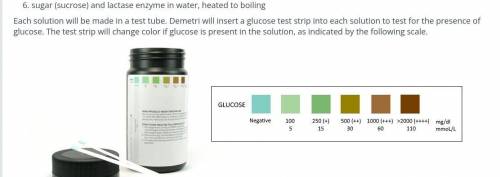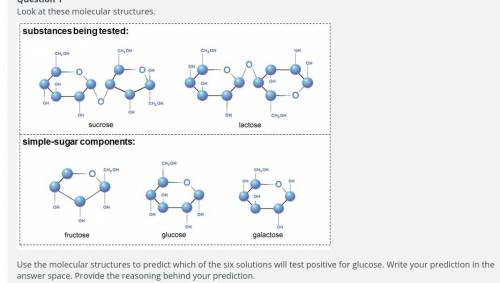HURRY 80 POINTS!!
Enzymes
In this activity, you will follow Demetri, a fellow biology studen...

Biology, 30.11.2021 23:30 87haymaker
HURRY 80 POINTS!!
Enzymes
In this activity, you will follow Demetri, a fellow biology student, as he tests the effects of the lactase enzyme in different conditions and on different solutions.
To begin the experiment, Demetri gathered these materials:
Materials
6 test tubes
safety goggles
3 400-mL beakers
1 microwaveable container
100-mL graduated cylinder
oven mitts
10-mL graduated cylinder
3 tablespoons sugar
a stirrer
75 mL milk
glucose test strips
250 mL water
2 lactase pills
masking tape
a pen
test tube rack
Demetri will use the materials to create the following six solutions:
milk (lactose) in water
milk (lactose) and lactase enzyme in water
milk (lactose) and lactase enzyme in water, heated to boiling
sugar (sucrose) in water
sugar (sucrose) and lactase enzyme in water
sugar (sucrose) and lactase enzyme in water, heated to boiling
Each solution will be made in a test tube. Demetri will insert a glucose test strip into each solution to test for the presence of glucose. The test strip will change color if glucose is present in the solution, as indicated by the following scale.
Part A: Hypothesis and Data Collection
Question 1
Look at these molecular structures. ( Look at images provided below )
Use the molecular structures to predict which of the six solutions will test positive for glucose. Write your prediction in the answer space. Provide the reasoning behind your prediction.



Answers: 1


Other questions on the subject: Biology


Biology, 21.06.2019 20:30, kendricklamar29
The collared lizard is a species found in the desert southwest. male collared lizards show considerable color variation, ranging from brightly colored to a very dull pattern. your goal is to determine the function, if any, of male color patterns in collared lizards, using the scientific method. your tentative explanation is that male color plays a role in attracting females for mating purposes. you predict that females will preferentially choose brightly colored males over dull-colored ones. to test this prediction, you observed the interactions of female collared lizards with their male counterparts. you selected males that were the same age and size, and that differed only in their coloration pattern. you placed equal numbers of the two types of male lizards, bright and dull, in aquariums, along with one female lizard per aquarium. out of 350 aquariums observed, the female chose to mate with the brightly colored male 277 times, and the dull-colored male 70 times. in 3 instances, the females did not mate with either type. create a bar graph of your data, plotting the type of male (dull or brightly colored) on the x-axis. on the y-axis, plot the frequency with which each type of male was chosen by females. using this graph, answer the following question(s). is it reasonable to conclude (i. e., is it supported by the data) that female collared lizards prefer more brightly colored male lizards over dull-colored males?
Answers: 3

Biology, 22.06.2019 03:00, JAXKBOII55951
Be in this im starting a with you so if you want you can get a partner for this. but basically im going to assign you guys a biome and you have to have a big sheet paper and you will turn it into 4 squares. the top right square is will be a drawing square for a drawing you will make of your biome. the top left square is about the biomes plants and drawings of them. the bottom left square is about the biomes animals. the bottem rights square is about the description of the biome. leave a comment or an answer and i will assign biomes. if your request one thats the one you get. send me a link to the project and i will grade ! im not a teacher btw.
Answers: 1

Biology, 22.06.2019 07:50, Amholloway13
Pentane with molecular formula c5h12, exists in three isomeric forms. one shows linear carbon chains, another has one -ch3 groups present on the third carbon atom, and the third has two -ch3 groups present on the second carbon atom. what types of isomers are these? a. geometric isomers b. structural isomers c. halotropic isomers
Answers: 3
You know the right answer?
Questions in other subjects:

Social Studies, 24.11.2020 19:30

Social Studies, 24.11.2020 19:30

Mathematics, 24.11.2020 19:30

Mathematics, 24.11.2020 19:30

Health, 24.11.2020 19:30




Social Studies, 24.11.2020 19:30




